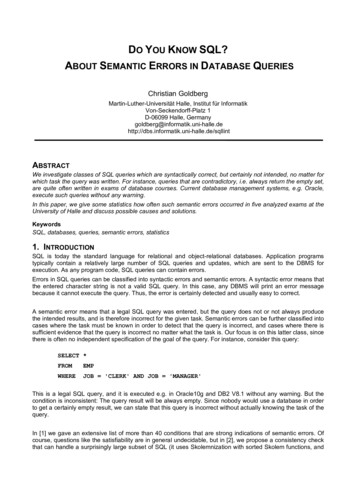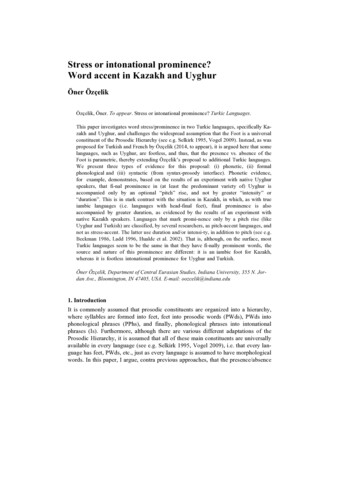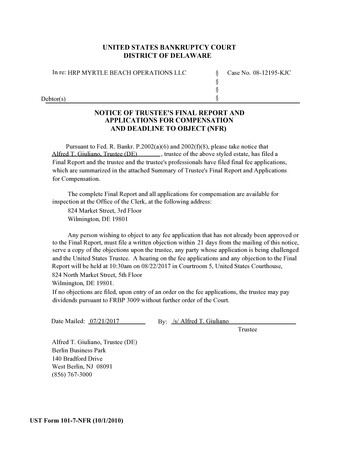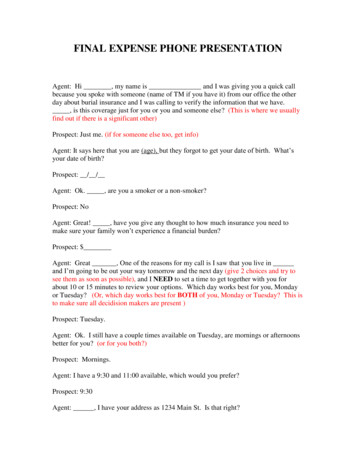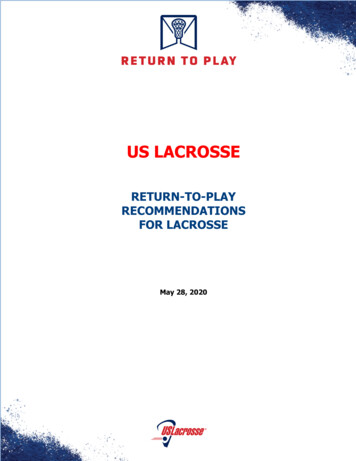
Transcription
US LACROSSERETURN-TO-PLAYRECOMMENDATIONSFOR LACROSSEMay 28, 2020
Table of ContentsOverview of Return To Play Recommendations for LacrosseComposition of US Lacrosse Return To Play Medical Advisory GroupComposition of Event Advisory GroupComposition of Sport Advisory GroupLacrosse Return To Play PrinciplesGeneral Return To Play GuidelinesLinks to State and Federal Public Health Guidance on COVID-19Stages For Return To Playing LacrosseStage 1 - At Home activityStage 2 - Small group activityStage 3 - Medium group activityStage 4 - Medium group activityStage 5 - Large group activityLinks to Guidance on Return To Play from Other National OrganizationsResourcesGuidance for Programs, Organizers and ParentsAppendix and Sample ResourcesCOVID-19 Action Plan (CAP) SampleHygiene or Safety Manager ResponsibilitiesSample Pre-Participation Wellness ScreenParticipation Waiver for Communicable Diseases Including COVID-19NSCA Guidelines on Safe Return to Training for AthletesResearch CitedMay 28, 021
Overview of Return To Play Recommendations for LacrosseThis document is designed to be an initial framework of guidelines to be used in planning for asafer return to the lacrosse field during, and after, the COVID-19 pandemic.These guidelines prioritize the protection of players, coaches, officials and volunteers, as well astheir families and friends. They are intended to provide program leaders with medically-informedguidance in the development of safer return to play protocols. These guidelines are grounded inpublic health recommendations established to address the mitigation of exposure risk to the spreadof COVID-19, which vary by community, county and state. The responsibility to safely returnathletes to the lacrosse field in the midst of a pandemic includes limiting exposure of athletes,coaches, officials, volunteers and parents to the virus, as well as assuring effective collaborationwith facilities, considering socio-economic barriers that may limit access, ensuring necessaryhygiene practices are implemented, and preventing athlete injury caused by extended inactivity, toname a few.These guidelines are not intended to serve as a replacement for professional medical advice,diagnosis or treatment by a licensed medical professional. The information regarding the preventionand treatment of COVID-19 is ever changing and, although these guidelines will be continuallyreviewed and updated, US Lacrosse cannot assure that this information is current or complete.Program leaders should always seek additional guidance from public health officials and medicalprofessionals to customize and continually update a return to play plan unique to the infection riskof their respective community. Additionally, states and counties have adopted a variety ofphased/staged approaches to resumption of activity, so the timetable to resume sport will differ bystate and county.As the sport's national governing body, US Lacrosse provides national leadership, structure andresources to fuel the sport's growth and enrich the experience of participants. While primarilyserving the youth level, US Lacrosse, a 501(c)3 nonprofit organization, is committed to providing aleadership role in virtually every aspect of the game. The US Lacrosse Center for Sport Science andits Sport Science & Safety Committee work tirelessly to elevate the safety initiatives that USLacrosse has been committed to since its creation in 1998, while providing health-related researchfunding and counsel since that time to improve the well-being of lacrosse participants at all levelsof play.US Lacrosse’s “Return to Playing Lacrosse” advisory group was established to help provide informedguidance to the lacrosse community as it relates to the current COVID-19 pandemic. The prioritiesfor the advisory group are to provide recommendations that mitigate the risk for all participants;explore innovative versions of the sport that allow for smaller number of athletes and coaches topractice, train and compete; and develop guidelines that allow for the return of the sport in agraduated manner along the following pathway: individual training, small group practices,competition, and ultimately, events with multiple teams and larger numbers of athletes andspectators.Any return to play options will be led first and foremost by federal, state and local public healthguidelines and mandates.May 28, 20203
The composition of the medical leadership team and the sport and event advisory members arelisted below:Medical Leadership Advisory TeamDavid Berkoff, MD*Richard Hinton, MD*Eugene Hong, MD* (Co-Chair)Kari Kindschi, MD**Matt Nein, CSCS*Karen Sutton, MD*Nina Walker, ATC*Andrew Wolanin, PsyD*Ann Kitt CarpenettiUniversity of North Carolina, Chapel Hill, N.C.MedStar Sports Medicine, Baltimore, Md.MUSC Health Charleston, S.C.MedStar Sports Medicine, Baltimore, Md.Salisbury University, Salisbury, Md.Hospital of Special Surgery (HSS), New York, NYUniversity of North Carolina, Chapel Hill, N.C.Wolanin Consulting, Philadelphia, Pa.VP, Lacrosse Operations, US LacrosseJay Dyer, CSCS**Kellie Loehr, ATC**Sean Huffman**(MedStar Sports Medicine) Baltimore, Md.(MedStar Sports Medicine) Baltimore, Md.(MedStar Sports Medicine) Baltimore, Md.*US Lacrosse Sport Science & Safety Committee members**Medstar Sports Medicine AdvisorsEvent Advisory TeamKim Rogers & JP FischerAndy BilelloLee CorriganE.W. BitterKelly GriffinMichael HaightKeith JacobyGeorge LeveilleIan McGinnisAshley G. MurphySteve SepataCharlie ShoulbergJamie VargaBecky WellsJoel ZuercherUS Lacrosse Events, Event Advisory staff leadsCorrigan Sports EnterprisesCorrigan Sports EnterprisesBitter LacrosseTop of the Bay SportsThinklax TournamentsUltimate Events and SportsSummit Lacrosse VenturesNXT SportsSummit Lacrosse VenturesAdrenaline LacrosseSTEPS LacrosseRaleigh LaxFestUltimate Events and SportsNXT SportsSport Advisory TeamErin SmithBrian AbbottLori BrownJ.B. ClarkePatty DaleyKevin FinnTamara FlorussBob GrossLaura JenningsDan LeventhalCynthia LisaMarc LuckettChristianne MaloneSusie MargottaJohn MoserLiz RobertshawUS Lacrosse Sport Development, Sport Staff LeadNational Intercollegiate Lacrosse Officials AssociationT3 LacrosseIntercollegiate Men's Lacrosse Coaches AssociationCollege Women's Lacrosse Officials AssociationTrue LacrosseJersey Girls Lacrosse Association, US Lacrosse BoardLong Island Metropolitan Lacrosse FoundationNorthern California Junior Lacrosse AssociationBronx LacrosseSt. Mary's (Md.) Girls' LacrosseUS Lacrosse BoardDetroit City Lacrosse, US Lacrosse BoardGreater Birmingham Youth Lacrosse AssociationCityLaxIntercollegiate Women's Lacrosse Coaches AssociationMay 28, 20204
Lacrosse Return to PlayThe Centers for Disease Control and Prevention recommends physical distancing of six-feetbetween people and the wearing of personal protective masks as fundamental interventions thatprevent the spread of COVID-19. These interventions have become widely adopted, and USLacrosse believes that lacrosse programs should adopt these interventions to the extent practicable.COVID-19 has the potential to cause serious illness and death in people of all ages and genders inall communities. Those who are immunocompromised, have co-morbid medical conditions and/orare over the age of 60 are at greatest risk. At the present time, testing and contact tracking are notwidely available, effective treatments have not been developed, and a vaccine is not expected to bewidely available for the foreseeable future. Additionally, while children appear to be at a lower riskto contract the virus, there is growing concern that they can be asymptomatic carriers who canexpose their respective parents and siblings to infection. Unfortunately, there is no way to eliminatethe risk of infection in this pandemic. Therefore, the goals of a safe return to play must focus onmitigating the risk of COVID-19 transmission, quickly identifying and removing participants whomay have contracted or been exposed to COVID-19 (and managing appropriately), and limiting theparticipation of vulnerable and at-risk populations. US Lacrosse and RPS Bollinger Insurance havedeveloped guidelines and FAQs for the insurance response to coronavirus. These address thespecific insurance coverages provided through the US Lacrosse Membership Insurance Plan andhow they will respond to claims arising from exposure or transmission of COVID-19. The guidelinescan be found on https://www.uslacrosse.org/return-to-play. Lacrosse program leaders who obtaininsurance outside the US Lacrosse Membership Insurance Plan should consult with their respectiveinsurance carriers to understand the coverages in place and related risk factors to the organizationand its participants as respects the pandemic. Once the risks of participation are understood and areturn to play plan is established to mitigate those risks, the organization should effectivelycommunicate the plan and ensure plan compliance.Nationally, many sports organizations have developed their own return to play guidelines related toCOVID-19, each of which emphasize a graduated return to play, physical distancing and, whenpossible/available, the appropriate use of screening, testing and tracking tools. Essential to thedevelopment and successful implementation of a return to play plan is the need to evolve andinnovate the lacrosse experience to assure that infection risks are mitigated while embracing theopportunity to evolve the traditional youth lacrosse experience. This evolution had already begun totake root prior to the pandemic through implementation of small-sided play, independent skillsdevelopment and more holistic goals for the youth sports experience. US Lacrosse has establishedan Athlete Development Model (ADM) https://www.uslacrosse.org/athlete-development thatfocuses on providing young athletes with a fun lacrosse experience that is based on their stage ofphysical, cognitive and emotional development. US Lacrosse offers many ADM resources onlinethat coaches, parents and programs can use as the foundation of a return to play plan.The risks of athletic participation and differences among low-to-high-risk sports is unclear.However, COVID-19 infection risk associated with occasional close quarters and incidental contactin a fast-paced outdoor athletic activity would appear to be less than the “grouping” activities thathave always been part of structured practice sessions. Young players huddled together forinstruction or groups of non-participating players socializing on the sidelines represent greaterinfection risks and are examples of traditional practice plans that must be eliminated.Until a vaccine or effective treatments are found, exposure time within a group setting must belimited to reduce infection risk. Therefore, practices should be efficiently planned to maximizeMay 28, 20205
player movement and minimize “together time.” Young players can work on individual skilldevelopment independently or with parents or other players in their community. Some coachinginstruction should be delivered on-line, before or after group practice sessions. Players need toarrive at practice sessions promptly, dressed and prepared. Kids need to be moving constantlythroughout practice. The goal for programs and coaches is to provide a safer environment based onbest public health practices, come to that environment prepared, train efficiently in group activities,get out of the group environment as quickly as reasonable, and stay connected with your team in avariety of low-risk ways in between practice sessions.There is a growing urgency for the return of sport in America, some of which is fueled by parentalexpectations, player aspirations, the financial pressures of youth sports organizations andbusinesses. Despite these circumstances, young athletes must be provided with a supportiveprogram focused on their health and welfare not just their value to others. Kids play sportsbecause they are fun. Let’s help them find that again in the safest manner possible.This initial set of return to play recommendations are designed to create and promote innovative,athlete-centered, developmentally appropriate and graduated lacrosse programming and activitiesthat allow for a staged return to play based on federal, state and local public health guidelines andbest practices. Lacrosse players and coaches are eager to return to the field as soon as possible.In order to achieve that goal, programs need to adapt the lacrosse experience in order to assurethat the health and safety of all participants remain the highest priorityGeneral Guidance on Return to PlayThe following CDC recommendations should be followed, regardless of the Return to Play stage inyour community, county or state. They currently include: Stay at home if you are feeling sick or experiencing the following COVID-19 symptoms:People with COVID-19 have had a wide range of symptoms reported – ranging from mildsymptoms to severe illness. Symptoms may appear 2-14 days after exposure to thevirus. People with these symptoms may have COVID-19:§ Cough§ Shortness of breath or difficulty breathing§ Fever of 100.3 degrees F/37.9 degrees C§ Chills§ Muscle pain§ Sore throat§ New loss of taste or smell*This list is not all possible symptoms. Other less common symptoms have been reported, includinggastrointestinal symptoms like nausea, vomiting, or /youthsports.html Clean and disinfect frequently touched surfaces and equipment (including balls,mouthguards, sticks, water bottles, helmets, eyewear, pads, uniform). No sharing of equipment, water bottles, towels.May 28, 20206
Thoroughly wash hands with soap and water for at least 20 seconds (sing “Happy Birthday”twice) or use an alcohol-based hand sanitizer that contains at least 60% alcohol. Have sanitizing options available, including, but not limited to hand sanitizer and disinfectantwipes. If capability exists, temperature of participants should be taken using an infraredthermometer. Anyone with a temperature of 100.3 degrees or more should be sent homeand evaluated by a licensed medical professional before being cleared to participate. Arrive dressed and ready to train. Minimize use of changing rooms, bathrooms, communal areas. Eat off-site. Bring own water bottle. Any tasks that can be done at home, should be done at home (recovery sessions, onlinemeetings). Cover your mouth and nose with elbow or tissue when coughing or sneezing. Follow the public health guidance of the host location for the lacrosse activity, whendetermining what necessary return to play and risk mitigation plan to follow. Each program should assign a designated safety or hygiene coordinator as the point ofcontact for all COVID-19 information, education and hygiene protocols. (See resources) Establish a CAP (COVID-19 Action Plan), to determine what steps you need to take, shouldan athlete, coach, or family member get sick or test positive for COVID-19. (See appendixfor sample CAP) Consistent with applicable law and privacy policies, have coaches, staff, umpires/officials,and families of players (as feasible) self-report to the youth sports organization if theyhave COVID-19, a positive test for COVID-19, or were exposed to someone with COVID-19within the last 14 days in accordance with other applicable laws and regulations. Notifystaff, officials, families, and the public of youth sports facility closures and restrictions inplace to limit COVID-19 exposure.The Centers for Disease Control and Prevention offers recommendations on how members of thepublic can limit the spread of the COVID-19. Check local public health recommendations andmandates in your area, found on your state and local government website, before headinganywhere for a lacrosse activity. A directory of state health departments and the latest data onCOVID-19 cases and deaths by U.S. county can be found here: Centers for Disease Control and PreventionWorld Health OrganizationState Departments of HealthMay 28, 20207
Stages for Return to Playing LacrosseThese guidelines consist of a “staged” return to play that is based on staged or phased return ofactivities established by most states and local public health departments. Factors such as newinfections of COVID-19, the rate of hospitalizations due to COVID-19, and the availability ofhealthcare resources in each community, county or state determine the stage or phase of activityallowed. The return to play “stages” in this document will broadly describe the activities that arerecommended, based on the level of risk that is associated with that activity, during that stage.Please refer to the CDC and your State Departments of Health to determine the recovery stage ofyour community, county or state.It is important to note that these stages are not intended to be followed in a linear manner, as itmay become necessary to return to prior staged guidance and activities, based on the everchanging status of COVID-19 exposure in the community, county or state that you are conductinglacrosse activities in. It is possible, if not likely, that there will be local and regional outbreaks andsurges of COVID-19 for some time to come.Younger children (under the age of 8) may not be best suited for any organized, modified grouplacrosse activity conducted in Stages 2 and 3, as younger children will have more difficultymaintaining social distancing and practicing recommended risk mitigation with their personalbelongings and equipment.This initial white paper will focus on guidance for lacrosse activities that US Lacrosse recommendsfor return during Stages 1 and 2, where we recommend youth lacrosse activities should be focusedon transitioning children back into physical activity through organized small-group practices andtraining exclusively, and not competition. Research has shown that introduction to full competitionactivity after a long span of deconditioning increases risk for significant musculoskeletal injury.Every effort should be made to have a gradual return to activity starting with drills and conditioningregardless of the community phase. At this time, we have found no current medical evidence thatwould suggest that a return to play that includes full-field, full-roster sized teams, competing in fulllength games or tournaments could occur without significant risk to participants. US Lacrosse willprovide more detailed guidance on Stage 5 in its Tier 2 recommendations, which will beissued by middle of June.Stage 1: At home individual training (mild risk) Aligned with state/local public healthguidelines that do not permit or recommend any size group gathering, outside of family members,in any public setting. At this stage, the community may be under a stay-at-home order by local orregional authorities. At this time, according to the CDC, there is large scale communitytransmission, healthcare staffing is significantly impacted, and there are multiple COVID-19 caseswithin communal settings like healthcare facilities, schools, mass gatherings, etc Goal: Hone sport-specific skills at home with individual drills that can be done in backyardor driveway. Prepare for sports participation with general cardiovascular conditioning, corework and body weight strength. Work on injury prevention activities, such as those offeredin the US Lacrosse LaxFit course (free to development-program/online-courses/laxfitMay 28, 20208
Stage 2: Small group (less than 10) modified lacrosse activity or practice at outdoorfacility (mild to moderate risk) Aligned with state/local public health guidelines that allow forsmall group (under 10) gatherings in a public or private setting. At this stage, according to theCDC, there is widespread and/or sustained transmission with high likelihood or confirmed exposurewithin communal settings with potential for rapid increase in suspected cases.Goal: Continue conditioning with small, socially-distanced community based groups.Improve hand-eye coordination, footwork, shooting skills. Continue improving cardiovascularand lacrosse fitness in a supportive group setting for enhanced mental and physical health.Stage 3: Medium group (less than 50) modified intra-squad scrimmages/practices withlimited closeness and contact at outdoor facility (moderate risk) Aligned with state/localpublic health guidelines that allow for under 10 people to gather in groups indoors at a time or upto 50 people to gather outdoors at a time. At this stage, according to the CDC, we are likely to seetransmission with likelihood or confirmed exposure within communal settings with potential forrapid increase in suspected cases.Goal: Once appropriate fitness levels are attained, this stage allows for increasing intensityand competitiveness in drills, including game-specific drills.Stage 4: Medium group (less than 50) local competition/ practices from teams withinsame locale, with limited closeness and contact at outdoor or indoor facility (moderateto high risk) no multi-team events Aligned with state/local public health guidelines that allowfor up to 50 people, to gather indoors or outdoors, at a time. At this stage, according to the CDC,sustained transmission with likelihood or confirmed exposure within communal settings withpotential for increase in suspected cases.Goal: Create a more competitive environment with local groups to enhance skills whileprotecting athletes from risks of travel and interactions with different communities withdifferent risk profiles.Stage 5: Larger group gatherings (more than 50) and full competition resumption withmultiple teams from varied geographic areas. (highest risk) Aligned with state/local publichealth guidelines that allow for groups larger than 50. At this stage, according to the CDC, there isevidence of isolated cases or limited community transmission, case investigations underway, noevidence of exposure in large communal setting, e.g., healthcare facility, school, mass gathering.Goal: Full return to larger competitive events, including participants from a variety ofcommunities/regions. Events should be evaluated for safety considerations and continueddiligence to mitigate virus transmission.May 28, 20209
Stage 1: At Home: Individual training (mild risk) Aligned with state/local public healthguidelines that do not permit or recommend any-size group gathering, outside of family members,in any public setting.1. All activities should follow guidelines listed in this document.HYGIENE/ DISTANCING2. Wear a cloth face covering that covers your nose and mouth in public settings.Athletes may wear a face mask during lacrosse activity. (see Athlete and ParentResponsibilities)3. Stay at least 6 feet away from non-household members.FACILITY/ VENUE4. Individual training sessions in your home/residence using your own equipment.TRAINING/ INJURY PREVENTION5. Virtual, 1v1 coaching6. Training sessions during this period should focus on skill concepts: wall ball,ground balls, shooting on empty cage.7. Individual strength and conditioning, speed and agility training ge 2: Small group (less than 10) Modified lacrosse activity or practice at outdoorfacility (mild to moderate risk) Aligned with state/ local public health guidelines that allow forsmall (under 10) group gatherings in a public or private setting.1. All activities should follow guidelines listed in this document.HYGIENE/ DISTANCING2. It is not known what the appropriate distancing is in an outdoor setting involvingphysical exertion (as in sport) that may mitigate the risk of transmission of COVID193. Establish a COVID Action Plan (CAP) to determine your pre-participation screeningrequirements for participants and for managing spread of COVID-19, should aparticipant become sick or test positive. (COVID-19 Action Plan) – see appendix forsample4. Transmission risk of COVID-19 will be greater the more time spent around others.5. Traveling across state lines or far distances to train or practice should be avoided.6. Exposure for COVID-19 transmission is higher when within 6 feet of a sick personfor more than 5 minutes. Stay at least 6 feet away from non-household members.Social distancing should be followed by those in attendance, at all times.7. Required face masks for staff, coaches, and designated adults serving ashygiene support for all practices and activities. Athletes may wear a face maskduring lacrosse activity. Face coverings should cover nose and mouth. (see Athleteand Parent Responsibilities)8. No huddles; no pre-or post-activity in-person meetings.9. No handshakes, high-fives, fist-bumps or skin-to-skin contact.May 28, 202010
FACILITY/ VENUE10. Individual training sessions in your home/ residence or at an approved publicoutdoor facility, using your own equipment. No indoor practices or events duringthis stage are recommended.11. No spectators (including parents) on or near the field during lacrosse practices oractivities. Parents should stay in vehicles during practices.12. Outdoor practices are recommended, over indoor practices, as outdoor venues arebetter ventilated than indoor venues. There are also benefits to mental healthdocumented, from even short engagements in green spaces. Risks of developingupper respiratory tract infections have also been reported at higher rates amongstathletes in indoor settings, compared to outdoor settings.13. Full-sized or half-sized fields may be used, as long as social distancing betweenplayers can be maintained, and drill stations on the field are spaced effectively toallow for room to safely conduct small group activities, during practices.TRAINING/ INJURY PREVENTION14. Before returning to practice, it’s imperative to conduct, at a minimum, a two-weekperiod of guided athletic skills training. Introduction of a proper dynamic warm-upand drills to acclimate athletes with multi-directional movement. The adaptationphase should be completed prior to implementing sport-specific skills and is likelyto change based on the frequency and age of participant.15. Focus should be getting back to practice, as more time is needed for conditioning,training in order to be ready to return to competition.16. A competition of any sort, even a small-sided competition should not be playedwithin stage two (even if 10 players are able to gather together), as potential forinjury is greater when competition is introduced.17. Coaches should make the most of the time together: communicate pre-practicewith athletes and parents, strategy and more in-depth coaching all done virtually.18. Recommend that practices should not include more than 8 athletes on the field, ata time (allows for one coach and one recommended hygiene coordinator).19. Assign area that ensures adequate physical distance between each player, for themto place their equipment and water, so that they can return to during breaks inactivity. Between training efforts, maintain a distance of at least 6 feet apart.20. Recommend that sessions should begin at 30 minutes in duration and following atransition period that can be evaluated every 2 weeks – can increase up to 60minutes, allows athletes to have a graduated return that minimizes contact andallows for play that follows the 50/30/20/10 workload/progression model (seeNSCA Resource document)21. Take training level of each athlete into account and establish new baselines foreach athlete. Coaches should introduce and implement use of a recoveryassessment tool upon arrival and at the conclusion of each session. The first phasecould consist of the following:i.Progression of linear short distance acceleration / decelerationii.Lateral movement (shuffle)iii.Core trainingiv.Low level (intensity) endurance22. Avoid contact drills or any drills that require standing in line.23. Training sessions or practices during this period should focus on skill concepts: wallball, ground balls, shooting, passing, clearing.24. Build in appropriate time for warm-up and cool-down, based on length of session.May 28, 202011
25. Time spent training should be well-planned by coaches or team leaders, timedappropriately to reduce time spent lingering on the field and efficient. Time spenttogether is productive practice time.26. Individual strength and conditioning os/https://www.youtube.com/watch?v mQ7-GTNqYgw27. Individual speed and agility training ression2016.pdf?opt id oeu1589241600036r0.5460679708048701Stage 3: Medium group (less than 50) Modified intra-squad scrimmages/practices withlimited closeness and contact at outdoor facility (moderate risk) Aligned with state/localpublic health guidelines that allow for under 10 people to gather in groups indoors at a time or upto 50 people, to gather outdoors at a time.*Follow all guidance provided for hygiene/ distancing, facility/event andtraining/prevention as referenced in Stage 2, unless any new recommendations areoutlined below:HYGIENE/ DISTANCING1. Required face masks for staff, coaches, officials and designated adults serving ashygiene support for all practices, scrimmages, games and activities. Athletes maywear a face mask during lacrosse activities. Face coverings should cover nose andmouth.FACILITY/ VENUE2. Group training sessions in your home/residence or at an approved public outdoorfacility, using your own equipment.TRAINING/ INJURY PREVENTION3. Competition with small or full roster sizes allowable. There remains a greaterpotential for injury when competition is introduced without adequate training.4. Competition options may include a 6v6 or 7v7 format to allow for fewer players.5. Recommend that practices allow for at least one coach and one recommendedh
US Lacrosse and RPS Bollinger Insurance have developed guidelines and FAQs for the insurance response to coronavirus. These address the specific insurance coverages provided through the US Lacrosse Membership Insurance Plan and how they will respond to claims arising


